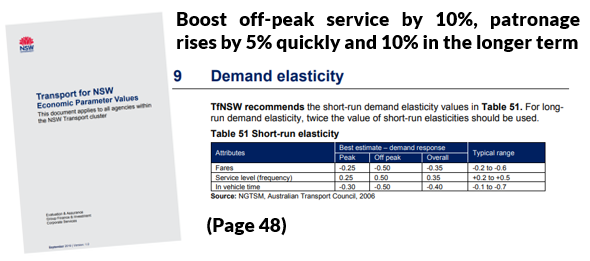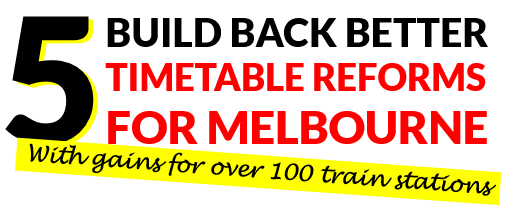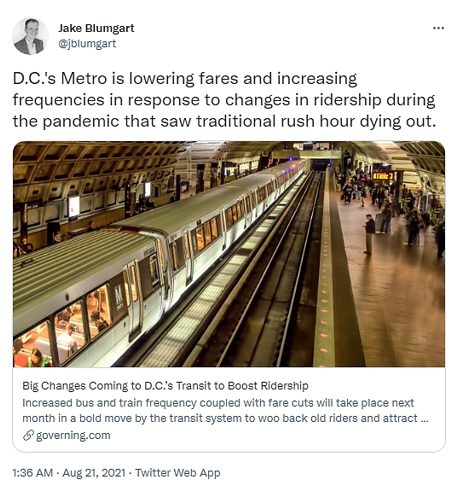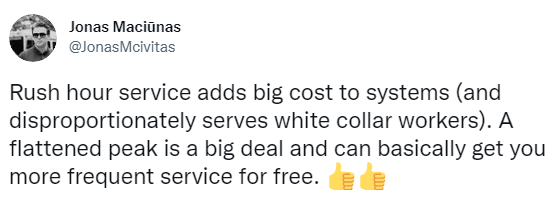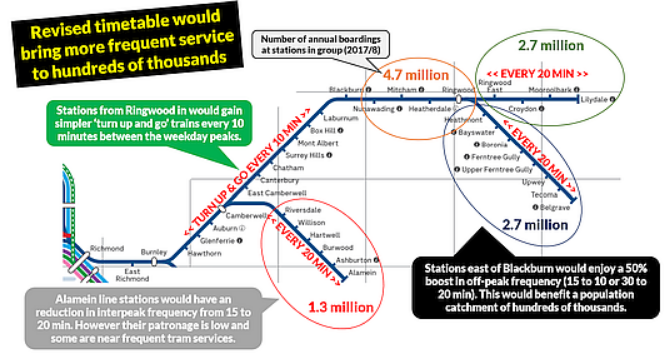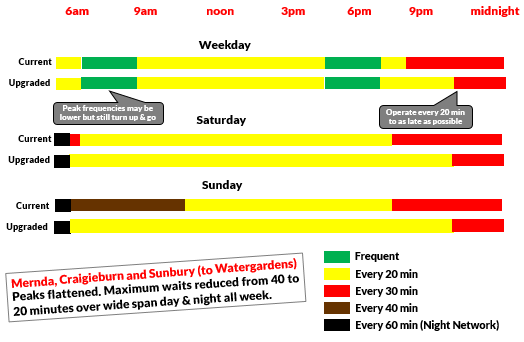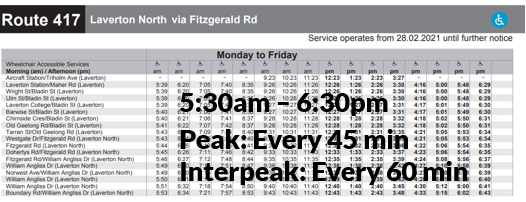A quick run-through Infrastructure Victoria's 30 year infrastructure strategy that was tabled in Parliament yesterday.
You can see it and all the associated papers here. This builds on the draft (which for now) can be found here.
There's two volumes, a major transport infrastructure assessment report, papers on costings, land use and emissions and fact sheets on specific major projects. It demands a capital spend of $100 billion over 30 years on many and varied projects and policy changes. It was prepared by Infrastructure Victoria, a body that provides advice to government on infrastructure challenges and needs.
What's in it? Keep reading! As it's so big I'll mainly stick to the public transport aspects.
Volume 1
* The term 'frequencies' appears 10 times, 'frequency' 18 times and 'frequent' 43 times. 'Network' 410 times, 'roads' 152 times, 'walking' 62 times, 'buses' 53 times, 'interchange' 8 times and 'turn up and go' just once.
* IV says we need a transport plan. Singular. And published. Like what VAGO recommended. That could be done this year and cost up to $10 million (Recommendation 33).
* Progress towards zero emissions a theme - both for private and public transport.
* Intelligent transport systems that could track buses and make traffic signals more responsive gets a mention in Recommendation 24.
* Charging for parking at stations and transport hubs is recommended. Also parking price reform in inner areas. Fair.
* Support for congestion pricing on new freeways (51). Some argue it should be on existing main roads which more often carry trams and buses. Recommendation 52 suggests this for inner Melbourne.
* Recommendation 41: Support for reallocating road space to priority modes.
* They're into the mobility as a service thing with apps and ticketing platforms. They want new providers to be able to bid for services currently run by buses. Regulatory reform is proposed (22). This is the flexible route stuff that I've written about here.
* Recommends rail electrification to Rockbank (not Melton), Beveridge and Wyndham Vale by 2031. Unusually prescriptive re operating patterns, including running Rockbank trains to Pakenham. More stations on Wyndham Vale and Melton corridors.
* A separate fact sheet discusses the Western Rail Corridor in more detail, though there electrification is described as being to Mt Atkinson. These services will use the Metro Tunnel, along with trains from Sunbury and Melbourne Airport. Thus there are three branches from the west and two in the east. I'll speculate here and presume that one line from the west, possibly Sunbury, will terminate somewhere in the east with airport trains going to Cranbourne and Rockbank trains to Pakenham. Specific frequencies are not mentioned but surely you'd ultimately want a 10 minute interpeak service on each west - east pair (though the Fact Sheet, being light on the service aspects, doesn't say this). A peak frequency on each line of 7.5 minutes (8 trains per hour) or 6 minutes (10 trains per hour) on each line would make for 24 to 30 trains per hour through the common Metro Tunnel section. That 10 trains per hour is about what the Sunbury line already gets in peak, although the HCMTs will add capacity. Also there could be unhelpful interactions between multiple lines including with V/Line trains which can chew up train paths if they are to operate at reasonable speeds. This is where capacity enhancements for Geelong and Metro 2 could come in, as discussed next. For a reason I cannot fathom, the fact sheet has a strange reference to Cheltenham in the south.
* Melbourne Metro 2 and associated projects. The biggest rail project mentioned is Melbourne Metro 2 which also gets its own fact sheet. This is tied with plans to speed up Geelong trains, boost capacity from Werribee, connect Fishermans Bend to the rail network (this being a development site that's currently poorly connected to the rest of Melbourne), and increase capacity on the Clifton Hill group. Also significant, according to rail advocates, could be the pressures through Sunshine and Footscray which would increase with the (partial) Melton line electrification mentioned above, not to mention the Airport line. The thinking appears to be that you can relieve this by electrifying Geelong trains and shifting them to run via the older and shorter alignment to Newport. From then they would run under the Yarra to Fishermans Bend and Southern Cross, thus relieving pressure near Footscray. The rest of MM2 would extend from Southern Cross to Clifton Hill via Flagstaff and a new station in the inner north. That could then form the Mernda line with Clifton Hill become an important connection point between the two different CBD operating patterns available.
* The Suburban Rail Loop appears on maps but doesn't get its own Fact Sheet or examination.
* Those in Melton and Clyde will be disappointed that they don't get rail electrification and an extension respectively advocated. Clyde and the whole area to the north towards Berwick is a massive growth area with buses as infrequent as once an hour. Other parts of the IV report suggest improved buses instead of rail for Clyde.
* The City Loop, with its archaic midday reversal still on 2 out of 4 lines, is an embarrassing carbuncle on our train network which continues to suffer from being a country system that aspires to be a metro but doesn't (yet) do that very well. The City Loop increases CBD coverage but makes travel confusing and slows some trips with interchanging particularly difficult. We'd be better off going to a through service model for more of our lines even if some people need to transfer. IV recommends, in 60, a reconfiguration to increase capacity and simplify operations by splitting the loop so that there is a path for trains from Richmond to North Melbourne via Parliament provided by some extra tunneling. This would be very cost-effective for the capacity released, especially if tacked on to the end of the Metro Tunnel project in a way that minimises disruption. A separate fact sheet has been prepared for this.
* Recommendation 59 of improving off-peak train services is important and would make the network much more useful. Improvements within 5 years are suggested. Also recommended is a 15 year service upgrade plan. This is good as service has been neglected for too long in favour of infrastructure. But I didn't see specific frequencies given nor even a multimodal coordination framework recommended. They draw on the PBO calculation of about $200 million per year but use a lower figure of $120 - 200 million. To that they add $4 - $10 billion in capital costs. Both these figures are in Vol 2.
* Parts of the tram network are getting full and network redesign is recommended (42). Melbourne Metro is a significant catalyst to this. Recommendation 43 proposes some tram network extensions including two routes to Fishermans Bend. Other possibilities include the Arden area, Footscray via Dynon Rd and the former Maribyrnong defence site. Accessibility is discussed in Recc 44.
* IV don't like the Caulfield - Rowville tram proposal. They want a 'next generation bus' instead. More on 'next generation' buses later.
* Suburban Rail Loop stations should be connected with a bus network to build patronage for the new stations. This is similar to my 'SRL SmartBus' concept, even though I would not necessarily follow all of the loop if better alternatives exist.
* Talks about 'next generation bus services' running Clyde, Mornington Peninsula, Wollert and Armstrong Creek in next year. Note: 788 is already slated for upgrade but its proposed 30 - 40 min frequency is not what one might expect from a premium route. Also, new bus services typically have much longer lead times than one year, at least in Victoria so I'm not sure how doable IV's plan is.
* State government funding for pedestrian infrastructure with local governments. Recommendation 38. At $150 - 250 million (or about the cost of a level crossing removal at one site) this looks small when compared to the billions that might be spent on a single road project. However it illustrates the low cost and likely high effectiveness of active transport projects. Cycling does better though with about 4 times more recommended (Recc 39). There is attention to the larger regional centres as well as Melbourne.
* Recommendation 57 is a key one dealing with buses. They see a need for more frequent and direct buses that people are willing to walk further to. They're on the right track here. SmartBus and reformed local bus networks in areas like Wyndham and Brimbank are cited as examples, though frequency in all three at certain times is often still too low and spans could be better.
* Recommendation 57 also refers to reforming Melbourne and Geelong's bus network. However they ignore the fact that Geelong's buses were completely reformed in 2015. Thus the most need for Geelong is merely growth area coverage and boosted frequencies on the largely existing network. Most of Melbourne though is in a different category with many unreformed routes and networks. Big bus network reforms in many (not all) metropolitan areas is very important, with recently reformed areas mainly just needing service upgrades. IV put an $85 million per year price tag on this, based on a 10% increase in bus network operating costs. $85m would represent the biggest bus boost in years but still strikes me as being too cheap for truly transformative change including all day 'turn-up-and-go' frequencies on main routes.
* The 'next generation' bus services are the top tier of a three level hierarchy which also includes middle level 'connector' and lower level 'local' bus routes. 'Next Generation' routes would be frequent direct services possibly on their own rights of way and using zero emission vehicles. The specifics with regarding frequency and operating hours are vague - a problem this strategy shares with Victoria's Bus Plan. Mention is made of coordination with other modes, though if they are at 'turn up and go' frequencies then this would not be necessary and be impossible anyway where many routes intersect. Connector routes are a middle level services. There is a tantalising mention of operating hours being coordinated with trams and trains which would require a large extension, especially in the evenings and weekends for these bus routes. Again there is no mention of frequency apart from coordinating with trains. Local routes are the lowest in the hierarchy. They needn't even be fixed routes, with explicit mention of Telebus (even though this was recently replaced with the similar 'Flexiride' in Rowville). You may wish to compare IV's hierarchy with my more specific one mentioned here in my discussion of Victoria's Bus Plan.
* La Trobe, Monash and Sunshine National Employment and Innovation Clusters would be the first in line to get improved transport, including 'next generation bus' services (Page 160). It should be noted that some of these have quite wide catchments with explicit mention of improved buses for Highpoint, Footscray and Hobsons Bay as these areas are within about 10km of Sunshine NEIC. My Friday Useful Network series has several items on better buses for these localities. If similar thinking was extended to La Trobe, this would cover areas like Preston, Reservoir, Thomastown, Epping and Heidelberg, whose bus networks are notoriously complex and unharmonised with trains. Similarly Monash's area might extend to areas like Caulfield, Glen Waverley, Mulgrave, Springvale and Dandenong North which need similar network reforms. $30 to $50m per year is suggested as an annual operating budget. Note this would be on top of the $85m for the similar Recommendation 57 that is applied over more areas.
* Recommendation 75 talks about 'next generation buses' to areas where you might consider electrified rail extensions such as Baxter and Wollert. IV make some interesting comments about the development effect of an extended Frankston line. They object to this on the basis that electrified rail extension would encourage sprawl on the Mornington Peninsula (which is agriculturally and environmentally important). Instead they suggest 'next generation buses' which apparently deliver similar mobility gains but would not shape or encourage development to the extent that rail might. The implication is that there is a 'rail effect' that shapes development in a way that buses don't. Clyde and Armstrong Creek are other areas that IV recommend better buses at least as stop-gap measures. Similarly with Wollert which is considered lower priority for rail than Melton or Wallan (and there would be frequency splitting issues where lines diverge at Lalor unless you force transfers there).
* The paper's lowlight is IV's now tedious tosh complaining about integrated fares. Page 130 refers to 'simplistic' fare structures which I'd have thought is good as people understand what they're paying. And they still don't like low income earners using the train (even if off-peak) so they'll make train travel dearer relative to bus travel. IV assumes that people can choose between bus and train for the same trip. This is usually mistaken and is not how an efficient network is configured as buses feed rather than parallel trains, with integrated fares required for this to work. Looking at how hard fare integration has been to get in other cities (with all sorts of complex ways to apportion revenue between operators and even different tiers of government), we are envied by many in having integration. We can't afford to lose what we have. IV are not even very good at economics as differential mode pricing may give rise to wasteful service planning that (for example) parallels trains with duplicative bus routes, with the buses hard to remove due to the cheaper fares they offer. Cities like Adelaide and Brisbane are examples where you can get to the CBD but few other places as buses and trains parallel rather than efficiently feed each other like they do in more developed networks such as operate in Melbourne or Perth. IV should definitely be ignored here. Cheaper fares, if thought necessary, should instead be done with off-peak discounts across all modes, which IV recommends elsewhere.
* Something else that should be ignored is Recommendation 48 on the transport price adviser. Such an advisor exists in Sydney (IPART) and they are the furthest from having genuinely integrated multimodal fares. Also fare policy should be integrated with service planning in the one transport authority or department since there are often interactions between them. Volume 2 appears to have some major inconsistencies with regard to the cost of implementing this recommendation.
* On firmer ground is support for permanent off-peak fare reductions. This could shift some trips to off-peak periods and relieve peak crowding. Also welcome is support for removing the inequitable 'Free Tram Zone' (Recc 47).
* Major road links. Recommendation 62 includes a connection between City Link and the Eastern Freeway - ie an 'east-west link' or 'cross city motorway' as they call it in one of their fact sheets. They're not enthusiastic about it as their wording is about 'preserving the option'. There is also an outer metropolitan ring road and railway. This would service the western and Beveridge intermodal freight terminals and support a lot of orbital car travel, especially from regional Victoria and to the airport by linking radial freeways including Hume, Calder, Western and Princes.
Volume 2
Includes a list of recommendations, comparisons against objectives, costs and timing. Look here if you want more details on the recommendations in Volume 1.
Major Transport Program Strategic Assessment
See this for a more detailed look at big road and rail projects including City Loop reconfiguration, Melbourne Metro 2, Cross-City motorway, Western Rail Corridor upgrade, Northern Rail Corridor upgrade, Outer Metropolitan Ring Road and more.
Driving down emissions: accelerating Victoria’s zero emission vehicle uptake
Read this for a roadmap of getting to zero. For both public and private vehicles. Page 10 has some sobering comments regarding the continued dominance of private vehicles, with them continuing to account for over 90% of motorised trips, despite investments in public transport infrastructure. The state's high projected population growth is given as a key reason for more driving,
The implication is that despite all the billions of dollars on public transport projects, these, current service policies and other transport portfolio policy settings will not deliver large-scale modal share shifts to public and active transport. Hence the stated importance of transitioning the private car fleet to zero emissions (in usage, not in their manufacture!). Given that most of our public transport (when measured by passenger trips) is already run by electric vehicles with that proportion to increase when electric buses come on stream, more consideration needs to be given on modal shift, noting its wider urban, social and liveability benefits. Cycling infrastructure to support the wider take-up of ebikes could be another cost-effective intervention as part of a low emission future.
Major Transport Program Capital Cost Report
See this for more detail on some of the major transport projects featured. This is good if you want to see the itemised scope for major projects. For instance the City Loop reconfiguration includes some northern rail corridor upgrade projects like new stations at Beveridge and Lockerbie, duplicating the Upfield line and electrification from there to Roxburgh Park.
However the infrastructure bias of the strategy is clear when there is no equivalent paper for service uplifts including routes, frequencies and operating costs of suggested off-peak service upgrades and the 'next generation buses'.
Victorian Land Use and Transport Integration (VLUTI) Model Architecture Report
Here you'll find an explanation of the Victorian Land Use and Transport Integration model used to assess transport demand. This is the 'boring but important' paper that talks about some of the assumptions used to assess the merit of projects and policies.
It's very complicated but I think the conclusion is that if you make something (including transport) better, cheaper and / or quicker then people are going to use it more. Conversely, make it worse, dearer or slower and they'll use it less, with some trips not made or shifted to a different time and/or mode. Someone else (can't remember who) said that transport demand behaves more like a gas than water - that is if you increase (say) road capacity or public transport frequency you'll get higher (induced) usage volume as people change their behaviour to favour greater use.
Also released
This wasn't the only major report related to transport infrastructure to come out yesterday. There were two others.
The Suburban Rail Loop Business and Investment Case was released.
And the Auditor-General reported on the capability to do major infrastructure projects.
Conclusion
Victoria's Infrastructure Strategy is good (sometimes very good) on some things like rail network planning, tram simplification, off-peak service improvements, top tier bus network reform, road charging and parking pricing. Although I thing it should have been even stronger on the service aspects with specific frequency targets and recommendations to remove 'pinch points' where infrastructure constraints either prevents high frequency service (where desired), compromises reliability or slows travel (particular for buses).
The fact that you can wade through hundreds of pages and not see a map for a multimodal frequent public transport network on its own rights of way is damning. Although maybe we should cut them some slack; after all they are called 'Infrastructure Victoria' and not 'Service Planning Victoria'. And they do commendably support measures that would better use our infrastructure like parking policy reform, road pricing, road space reallocation and unspecified (but probably under-baked) off-peak public transport service upgrades.
You should be wary about the roles assigned for 'flexible route' buses and transport payment systems spruiked by tech-geeks. The former risks having over-blown benefits versus its cost with very variable travel times and low usage in many places it's been tried. While the latter risks being a next generation scratch ticket/Metcard/Myki type time-waster that diverted attention from the basics of useful networks like span and frequency during much of the 1990s and 2000s while we obsessed about ticketing media. This retarded our network's development for many years and we still have main road bus timetables that bear the scars of early '90s cuts and no improvements in 30 state government budgets since. It's important to focus on what truly matters to avoid repeating such unproductive diversions in the future.
Finally, when it comes to their crackpot scheme to disintegrate fares between modes, you know what to do. Just say no no no!
See more Building Melbourne's Useful Network items here



